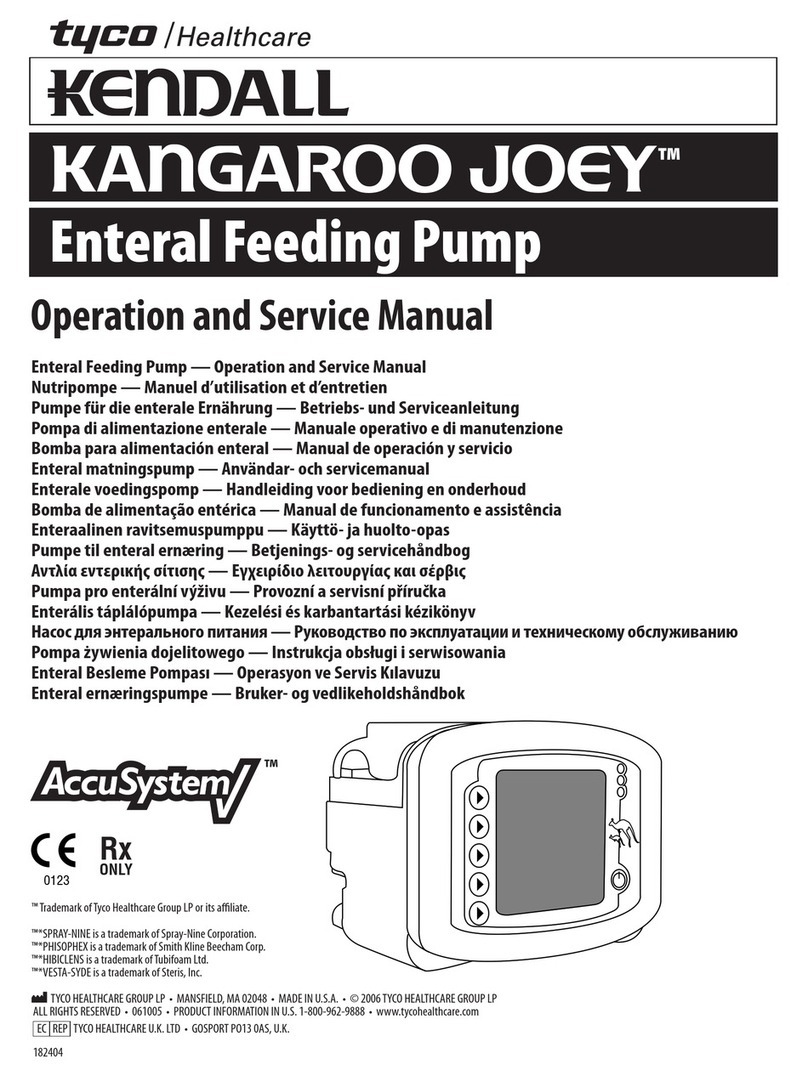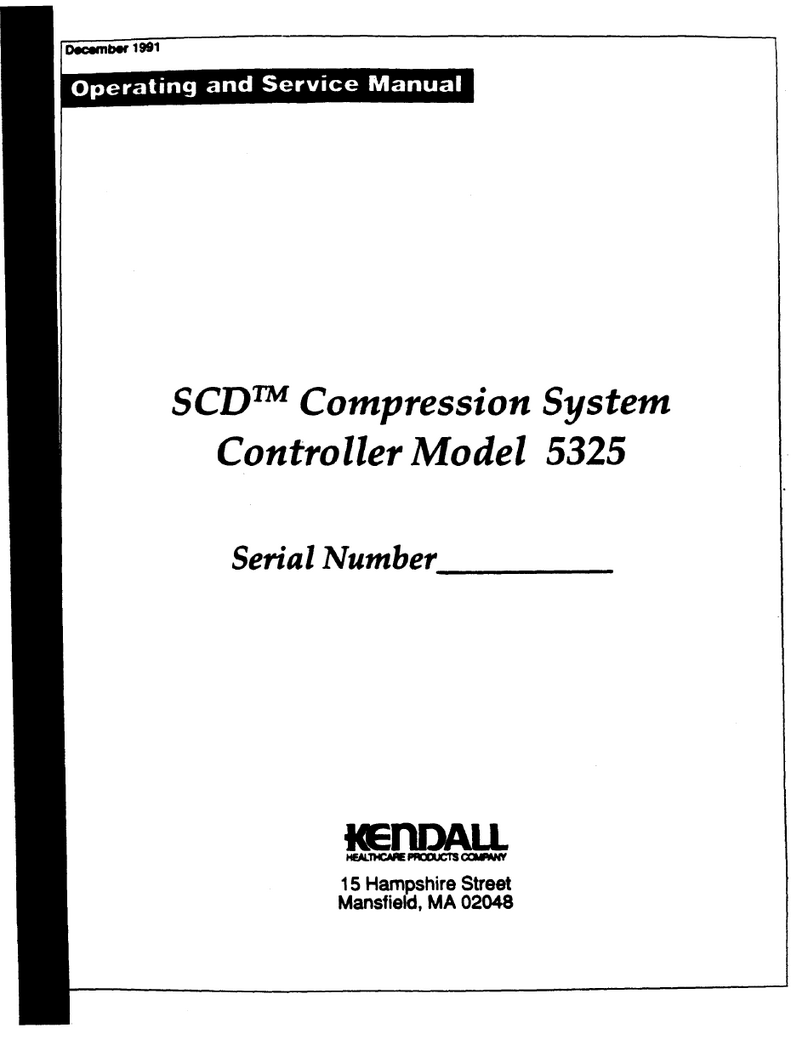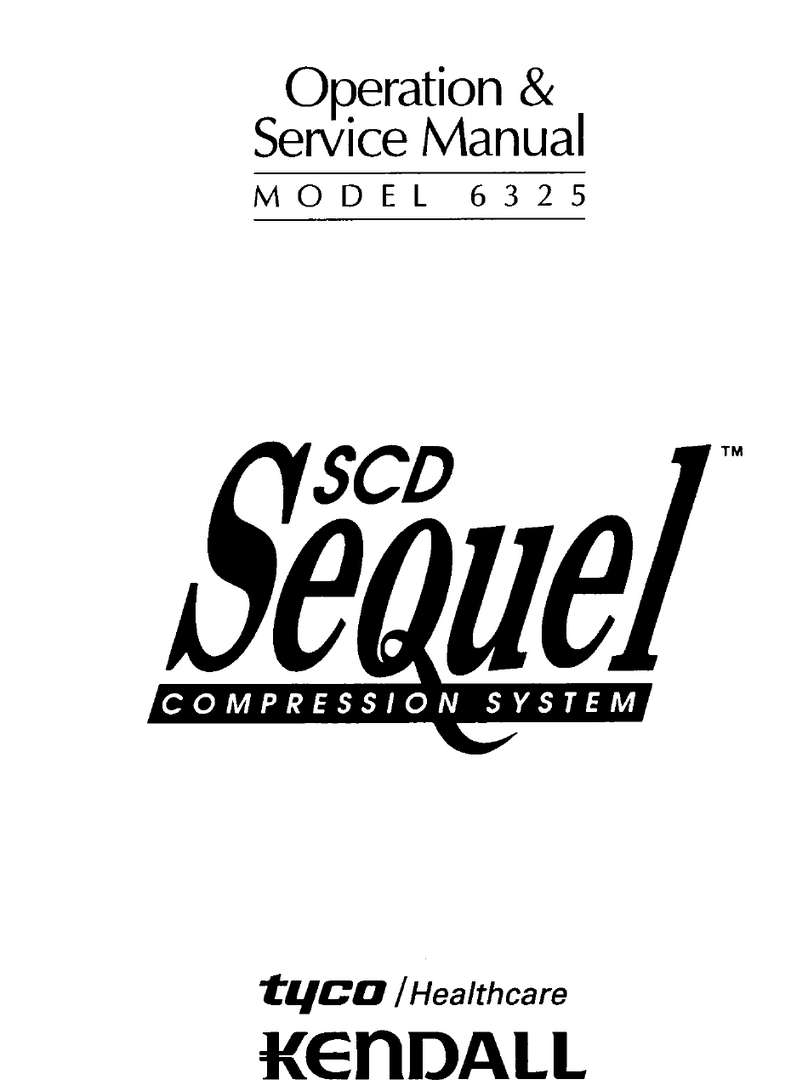
To prevent a potential shock hazard, the battery compartment should not be left vacant while operating the SCD EXPRESS Compres-
sion System. The battery pack, or a dummy pack (if so equipped), must be installed in the controller to prevent the user from having access
to the battery’s electrical connection.
Compression System is optional. To order
new or replacement battery
please contact Kendall Customer Service.
Battery State Battery Status 1 Battery Status 2 Battery Status 3
Battery State Battery Status 1 Battery Status 2 Battery Status 3
Battery State Battery Status 1 Battery Status 2 Battery Status 3
Battery State Battery Status 1 Battery Status 2 Battery Status 3
100% charge Green Green Green
100% charge Green Green Green
100% charge Green Green Green
100% charge Green Green Green
67-99% charge Green Green Green (Pulsing)
67-99% charge Green Green Green (Pulsing)
67-99% charge Green Green Green (Pulsing)
67-99% charge Green Green Green (Pulsing)
34-66% charge Green Green (Pulsing) Off
34-66% charge Green Green (Pulsing) Off
34-66% charge Green Green (Pulsing) Off
34-66% charge Green Green (Pulsing) Off
0-33% charge Green (Pulsing) Off Off
0-33% charge Green (Pulsing) Off Off
0-33% charge Green (Pulsing) Off Off
0-33% charge Green (Pulsing) Off Off
t plugged in and Powered On (Charging)
Battery Status 1 Battery Status 2 Battery Status 3
Battery Status 1 Battery Status 2 Battery Status 3
Battery Status 1 Battery Status 2 Battery Status 3
67-100% charge Green Green Green
67-100% charge Green Green Green
67-100% charge Green Green Green
67-100% charge Green Green Green
34-66% charge Green Green Off
34-66% charge Green Green Off
34-66% charge Green Green Off
34-66% charge Green Green Off
< 34% charge Green Off Off
< 34% charge Green Off Off
< 34% charge Green Off Off
< 34% charge Green Off Off
15-40 minutes left* Amber (Flashing) Off Off
15-40 minutes left* Amber (Flashing) Off Off
15-40 minutes left* Amber (Flashing) Off Off
15-40 minutes left* Amber (Flashing) Off Off
< 15 minutes left* Red (Flashing) Off Off
< 15 minutes left* Red (Flashing) Off Off
< 15 minutes left* Red (Flashing) Off Off
< 15 minutes left* Red (Flashing) Off Off
Unit not plugged in and Powered On (Operating on Battery)
Powered Off (charging when plugged in)
Battery State Battery Status 1 Battery Status 2 Battery Status 3
Battery State Battery Status 1 Battery Status 2 Battery Status 3
Battery State Battery Status 1 Battery Status 2 Battery Status 3
Battery State Battery Status 1 Battery Status 2 Battery Status 3
0-100% charge Off Off Off
0-100% charge Off Off Off
0-100% charge Off Off Off
0-100% charge Off Off Off
The battery will begin charging as soon as the unit is plugged into an AC power source. The amount of time required to charge the battery will vary
depending on the battery’s overall condition, age, and the controller’s state during charging. For example, charging a new, fully drained battery will
take approximately 4 hours with the controller on standby and 8 hours with the controller powered on. The Battery Status indicators should always be
used to determine the state of charge for the battery. A fully charged battery will typically provide 6-8 hours of operation time depending on the sleeve
configuration, sleeve application, and the battery condition.
If the operation time on battery power is extremely short the battery should be returned for service or replace
The battery may sustain permanent damage and become unrecoverable if it is left
unused for extended periods of
the battery pack be stored with a minimum charge of 50% and kept near 25
if prolonged storage is necessary.
* With 15-40 minutes of battery charge left, an alarm will sound in a sequence of three beeps once every two minutes. Once
there is less than 15 minutes of battery charge left, the alarm will sound continuously.






























